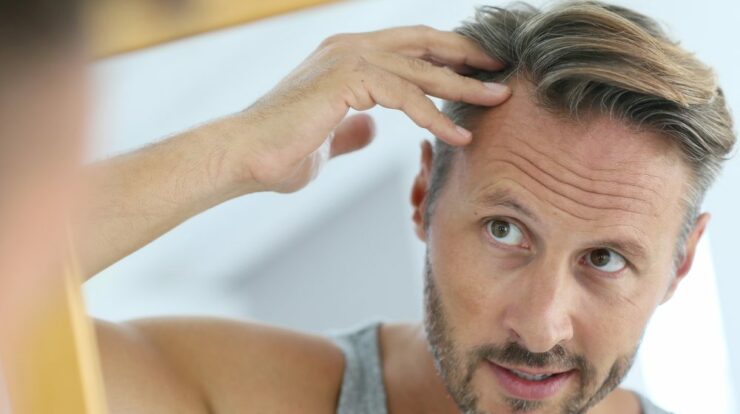
Hair loss is something men of all ages can deal with. But as you get older, male pattern baldness is more likely to affect your head of hair. It’s not uncommon and is usually driven by a person’s genes. Still, it doesn’t make losing your hair more comforting or less embarrassing.
Men may be tempted to reach for a convenient solution — hiding bald spots under a baseball cap. After all, plenty of people wear hats to make a statement and protect themselves from the sun. But what about situations where wearing a cap isn’t allowed or socially acceptable? Viable alternatives exist if you want to stop covering up your thinning hair. Below we’ll explore hair loss challenges and offer advice about restoring growth.
Understanding Male Pattern Baldness
Male pattern baldness isn’t the only reason for hair loss. However, it’s one of the most common causes of thinning hair for males. Typical signs of male pattern baldness include a receding hairline. You may also notice less hair on the top of your head.
It may start out as fewer strands, revealing some scalp where you didn’t see it before. Gradually, the hair stops growing, making your scalp 100% visible. Treatments such as topical finasteride can address hair loss from male pattern baldness. It reduces thinning and stimulates regrowth by targeting the underlying cause.
In 95% of male patients with hair loss, their DNA makes their hair follicles more sensitive to the hormone DHT. It’s an androgen responsible for the development of male reproductive characteristics. But when your hair follicles are sensitive to DHT, they can shrink and stop growing hair. The shrinking process doesn’t happen overnight but produces thinner, shorter strands. And over time, your hair follicles stop growing hair altogether.
When Does Hair Loss Start?
Hair loss from male pattern baldness affects two-thirds of individuals assigned male at birth. Early signs typically begin in your 30s. You might think you’re too young to deal with hair loss at that age. However, two out of three males experience it by age 35. For some people, the early stages of male pattern baldness begin in their teens and 20s.
Your family history can influence when hair loss starts and its severity. While there’s some debate on which side of the genetic pool hair thinning comes from, both sides can have an impact. Your risk increases whether male pattern baldness exists on your father’s or mother’s side.
Besides family history, one of the biggest risk factors is age. About 25% of individuals assigned male at birth experience signs of hair loss before 21. But by age 50, half of the male population sees thinning hair. And around 70% will experience hair loss as they surpass middle age. Treating thinning hair right away can prevent further loss and some of the anxiety that comes with it.
Additional Reasons for Hair Loss
Even though male pattern baldness is the most common reason for hair loss, DNA isn’t the only cause. Autoimmune disorders, scalp infections, stress, and diet can lead to hair loss. Once a licensed medical professional diagnoses scalp infections and autoimmune disorders, you can begin treatment for the disease, reversing symptoms like hair loss.
Another possible cause is medications. If you take isotretinoin for acne or steroids, you might experience thinning hair. Stopping the medication can restore hair growth with time. Reducing sources of stress might also help reverse anxiety-induced hair loss. You may need to find better coping methods like daily meditation or reframing techniques.
Reframing techniques teach you to look at situations through a different lens. Instead of seeing sources of stress as pure threats, you broaden your perception. Stressors can be surmountable obstacles or even opportunities for personal growth. Coping techniques could include deep breathing, calming the mind, and not responding immediately.
Dietary causes may include not enough iron and protein. Once you boost your intake, your hair follicles will get the nutrients they need to grow healthy strands. You may also find success with anti-inflammatory diets.
Is There a Cure for Male Pattern Hair Loss?
No, there isn’t a cure for male pattern hair loss yet. The medical community may know more about DNA than it did in the past. But science hasn’t discovered a way to cure genetic causes of hair loss. Until it does, the U.S. Food and Drug Administration has approved two medications to treat it.
Those medications are minoxidil and finasteride. You can get minoxidil over the counter. It’s a topical treatment you apply to your scalp twice a day. Not everyone sees results from minoxidil, but it can reduce hair loss and stimulate growth. It typically takes six months to a year to see a difference.
The other approved treatment is finasteride, which comes in oral and topical forms. While finasteride requires a prescription, you can use it with minoxidil. Finasteride blocks DHT, so your hair follicles don’t shrink from it. But like minoxidil, you have to keep using it to maintain hair growth. A consultation with a medical provider can reveal whether one or both medications will be right for you.
Treating Male Hair Loss
You don’t have to hide your hair loss under a baseball cap for the rest of your life. Rest assured male pattern baldness is usually caused by factors beyond your control and is far from unusual. Nonetheless, you can take charge of your situation by seeking treatment. Once you do, you’ll be on your way to restoring your hair growth and desired appearance.


